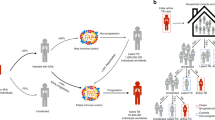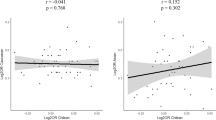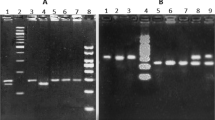Abstract
Chromosome 5q31 spans the T helper (Th) 2-related cytokine gene cluster, which is potentially important in Th1/Th2 immune responses. The chromosome 5q23.2–31.3 has been recently identified as a region with suggestive evidence of linkage to tuberculosis in the Asian population. With the aim of fine-mapping a putative tuberculosis susceptibility locus, we investigated a family-based association test between the dense single nucleotide polymorphism (SNP) markers within chromosome 5q31 and tuberculosis in 205 Thai trio families. Of these, 75 SNPs located within candidate genes covering SLC22A4, SLC22A5, IRF1, IL5, RAD50, IL13, IL4, KIF3A and SEPT8 were genotyped using the DigiTag2 assay. Association analysis revealed the most significant association with tuberculosis in haplotypes comprising SNPs rs274559, rs274554 and rs274553 of SLC22A5 gene (PGlobal=2.02 × 10−6), which remained significant after multiple testing correction. In addition, two haplotypes within the SLC22A4 and KIF3A region were associated with tuberculosis. Haplotypes of SLC22A5 were significantly associated with the expression levels of RAD50 and IL13. The results show that the variants carried by the haplotypes of SLC22A4, SLC22A5 and KIF3A region potentially contribute to tuberculosis susceptibility among the Thai population.
This is a preview of subscription content, access via your institution
Access options
Subscribe to this journal
Receive 6 digital issues and online access to articles
$119.00 per year
only $19.83 per issue
Buy this article
- Purchase on Springer Link
- Instant access to full article PDF
Prices may be subject to local taxes which are calculated during checkout

Similar content being viewed by others
References
Bloom BR, Small PM . The evolving relation between humans and Mycobacterium tuberculosis. N Engl J Med 1998; 338: 677–678.
Comstock GW . Tuberculosis in twins: a re-analysis of the Prophit survey. Am Rev Respir Dis 1978; 117: 621–624.
van der Eijk EA, van de Vosse E, Vandenbroucke JP, van Dissel JT . Heredity versus environment in tuberculosis in twins: the 1950s United Kingdom Prophit Survey Simonds and Comstock revisited. Am J Respir Crit Care Med 2007; 176: 1281–1288.
Bellamy R, Beyers N, McAdam KP, Ruwende C, Gie R, Samaai P et al. Genetic susceptibility to tuberculosis in Africans: a genome-wide scan. Proc Natl Acad Sci USA 2000; 97: 8005–8009.
Cervino AC, Lakiss S, Sow O, Bellamy R, Beyers N, Hoal-van Helden E et al. Fine mapping of a putative tuberculosis-susceptibility locus on chromosome 15q11-13 in African families. Hum Mol Genet 2002; 11: 1599–1603.
Campbell SJ, Sabeti P, Fielding K, Sillah J, Bah B, Gustafson P et al. Variants of the CD40 ligand gene are not associated with increased susceptibility to tuberculosis in West Africa. Immunogenetics 2003; 55: 502–507.
Miller EN, Jamieson SE, Joberty C, Fakiola M, Hudson D, Peacock CS et al. Genome-wide scans for leprosy and tuberculosis susceptibility genes in Brazilians. Genes Immun 2004; 5: 63–67.
Jamieson SE, Miller EN, Black GF, Peacock CS, Cordell HJ, Howson JM et al. Evidence for a cluster of genes on chromosome 17q11-q21 controlling susceptibility to tuberculosis and leprosy in Brazilians. Genes Immun 2004; 5: 46–57.
Baghdadi JE, Orlova M, Alter A, Ranque B, Chentoufi M, Lazrak F et al. An autosomal dominant major gene confers predisposition to pulmonary tuberculosis in adults. J Exp Med 2006; 203: 1679–1684.
Cooke GS, Campbell SJ, Bennett S, Lienhardt C, McAdam KP, Sirugo G et al. Mapping of a novel susceptibility locus suggests a role for MC3R and CTSZ in human tuberculosis. Am J Respir Crit Care Med 2008; 178: 203–207.
Mahasirimongkol S, Yanai H, Nishida N, Ridruechai C, Matsushita I, Ohashi J et al. Genome-wide SNP-based linkage analysis of tuberculosis in Thais. Genes Immun 2009; 10: 77–83.
Rihet P, Traore Y, Abel L, Aucan C, Traore-Leroux T, Fumoux F . Malaria in humans: Plasmodium falciparum blood infection levels are linked to chromosome 5q31-q33. Am J Hum Genet 1998; 63: 498–505.
Flori L, Kumulungui B, Aucan C, Esnault C, Traore AS, Fumoux F et al. Linkage and association between Plasmodium falciparum blood infection levels and chromosome 5q31-q33. Genes Immun 2003; 4: 265–268.
Marquet S, Abel L, Hillaire D, Dessein A . Full results of the genome-wide scan which localises a locus controlling the intensity of infection by Schistosoma mansoni on chromosome 5q31-q33. Eur J Hum Genet 1999; 7: 88–97.
Rioux JD, Silverberg MS, Daly MJ, Steinhart AH, McLeod RS, Griffiths AM et al. Genomewide search in Canadian families with inflammatory bowel disease reveals two novel susceptibility loci. Am J Hum Genet 2000; 66: 1863–1870.
Rioux JD, Daly MJ, Silverberg MS, Lindblad K, Steinhart H, Cohen Z et al. Genetic variation in the 5q31 cytokine gene cluster confers susceptibility to Crohn disease. Nat Genet 2001; 29: 223–228.
Kawashima T, Noguchi E, Arinami T, Yamakawa-Kobayashi K, Nakagawa H, Otsuka F et al. Linkage and association of an interleukin 4 gene polymorphism with atopic dermatitis in Japanese families. J Med Genet 1998; 35: 502–504.
Friberg C, Bjorck K, Nilsson S, Inerot A, Wahlstrom J, Samuelsson L . Analysis of chromosome 5q31-32 and psoriasis: confirmation of a susceptibility locus but no association with SNPs within SLC22A4 and SLC22A5. J Invest Dermatol 2006; 126: 998–1002.
Marsh DG, Neely JD, Breazeale DR, Ghosh B, Freidhoff LR, Ehrlich-Kautzky E et al. Linkage analysis of IL4 and other chromosome 5q31.1 markers and total serum immunoglobulin E concentrations. Science 1994; 264: 1152–1156.
Postma DS, Bleecker ER, Amelung PJ, Holroyd KJ, Xu J, Panhuysen CI et al. Genetic susceptibility to asthma--bronchial hyperresponsiveness coinherited with a major gene for atopy. N Engl J Med 1995; 333: 894–900.
A genome-wide search for asthma susceptibility loci in ethnically diverse populations. The Collaborative Study on the Genetics of Asthma (CSGA). Nat Genet 1997; 15: 389–392.
Li-Weber M, Krammer PH . Regulation of IL4 gene expression by T cells and therapeutic perspectives. Nat Rev Immunol 2003; 3: 534–543.
Lee GR, Fields PE, Griffin TJ, Flavell RA . Regulation of the Th2 cytokine locus by a locus control region. Immunity 2003; 19: 145–153.
Onnie C, Fisher SA, King K, Mirza M, Roberts R, Forbes A et al. Sequence variation, linkage disequilibrium and association with Crohn's disease on chromosome 5q31. Genes Immun 2006; 7: 359–365.
Seah GT, Scott M, Rock GAW . Type 2 cytokine gene activation and its relationship to extend of disease in patients with tuberculosis. J Infect Dis 2000; 181: 385–389.
Harris J, De Haro SA, Master SS, Keane J, Roberts EA, Delgado M et al. T helper 2 cytokines inhibit autophagic control of intracellular Mycobacterium tuberculosis. Immunity 2007; 27: 505–517.
van Soolingen D, Qian L, de Haas PE, Douglas JT, Traore H, Portaels F et al. Predominance of a single genotype of Mycobacterium tuberculosis in countries of East Asia. J Clin Microbiol 1995; 33: 3234–3238.
Manca C, Reed MB, Freeman S, Mathema B, Kreiswirth B, Barry III CE et al. Differential monocyte activation underlies strain-specific Mycobacterium tuberculosis pathogenesis. Infect Immun 2004; 72: 5511–5514.
Nuchnoi P, Ohashi J, Naka I, Nacapunchai D, Tokunaga K, Nishida N et al. Linkage disequilibrium structure of the 5q31-33 region in a Thai population. J Hum Genet 2008; 53: 850–856.
Barrett JC, Hansoul S, Nicolae DL, Cho JH, Duerr RH, Rioux JD et al. Genome-wide association defines more than 30 distinct susceptibility loci for Crohn's disease. Nat Genet 2008; 40: 955–962.
Peltekova VD, Wintle RF, Rubin LA, Amos CI, Huang Q, Gu X et al. Functional variants of OCTN cation transporter genes are associated with Crohn disease. Nat Genet 2004; 36: 471–475.
van Crevel R, Karyadi E, Preyers F, Leenders M, Kullberg BJ, Nelwan RH et al. Increased production of interleukin 4 by CD4+ and CD8+ T cells from patients with tuberculosis is related to the presence of pulmonary cavities. J Infect Dis 2000; 181: 1194–1197.
Vale RD . The molecular motor toolbox for intracellular transport. Cell 2003; 112: 467–480.
Little KY, McLaughlin DP, Zhang L, Livermore CS, Dalack GW, McFinton PR et al. Cocaine, ethanol, and genotype effects on human midbrain serotonin transporter binding sites and mRNA levels. Am J Psychiatr 1998; 155: 207–213.
Nishida N, Tanabe T, Takasu M, Suyama A, Tokunaga K . Further development of multiplex single nucleotide polymorphism typing method, the DigiTag2 assay. Anal Biochem 2007; 364: 78–85.
Barrett JC, Fry B, Maller J, Daly MJ . Haploview: analysis and visualization of LD and haplotype maps. Bioinformatics 2005; 21: 263–265.
O’Connell JR, Weeks DE . PedCheck: a program for identification of genotype incompatibilities in linkage analysis. Am J Hum Genet 1998; 63: 259–266.
Abecasis GR, Cherny SS, Cookson WO, Cardon LR . GRR: graphical representation of relationship errors. Bioinformatics 2001; 17: 742–743.
Lange C, DeMeo D, Silverman EK, Weiss ST, Laird NM . PBAT: tools for family-based association studies. Am J Hum Genet 2004; 74: 367–369.
Luna A, Nicodemus KK . snp.plotter: an R-based SNP/haplotype association and linkage disequilibrium plotting package. Bioinformatics 2007; 23: 774–776.
Nyholt DR . A simple correction for multiple testing for single-nucleotide polymorphisms in linkage disequilibrium with each other. Am J Hum Genet 2004; 74: 765–769.
Gabriel SB, Schaffner SF, Nguyen H, Moore JM, Roy J, Blumenstiel B et al. The structure of haplotype blocks in the human genome. Science 2002; 296: 2225–2229.
Purcell S, Neale B, Todd-Brown K, Thomas L, Ferreira MA, Bender D et al. PLINK: a tool set for whole-genome association and population-based linkage analyses. Am J Hum Genet 2007; 81: 559–575.
Lee PH, Shatkay H . F-SNP: computationally predicted functional SNPs for disease association studies. Nucleic Acids Res 2008; 36: D820–D824.
Dudbridge F . Likelihood-based association analysis for nuclear families and unrelated subjects with missing genotype data. Hum Hered 2008; 66: 87–98.
Acknowledgements
This study was partly supported by International Cooperation Research grant, the Ministry of Health, Labor and Welfare from 2002 to 2004 and by a grant-in-aid for scientific research on priority areas ‘Comprehensive Genomics’ from the Ministry of Education, Culture, Sports, Science and Technology of Japan and intramural grant from Department of Medical Sciences, Ministry of Public Health, Thailand. We thank all staffs and collaborators of the TB/HIV research project, Thailand, a collaborative research project between the Research Institute of Tuberculosis (RIT) and the Japan Anti-tuberculosis Association, and the Department of Medical Sciences, Ministry of Public Health for collecting the clinical information and samples.
Author information
Authors and Affiliations
Corresponding author
Ethics declarations
Competing interests
The authors declare no conflict of interest.
Additional information
Supplementary Information accompanies the paper on Genes and Immunity website
Supplementary information
Rights and permissions
About this article
Cite this article
Ridruechai, C., Mahasirimongkol, S., Phromjai, J. et al. Association analysis of susceptibility candidate region on chromosome 5q31 for tuberculosis. Genes Immun 11, 416–422 (2010). https://doi.org/10.1038/gene.2010.26
Received:
Revised:
Accepted:
Published:
Issue Date:
DOI: https://doi.org/10.1038/gene.2010.26
Keywords
This article is cited by
-
Association Analysis of Interleukin-17 Gene Polymorphisms with the Risk Susceptibility to Tuberculosis
Lung (2016)
-
Diagnostic value of blood gene expression signatures in active tuberculosis in Thais: a pilot study
Genes & Immunity (2015)
-
KIF3A, a Cilia Structural Gene on Chromosome 5q31, and Its Polymorphisms Show an Association with Aspirin Hypersensitivity in Asthma
Journal of Clinical Immunology (2011)



